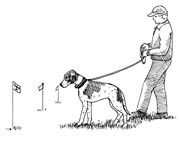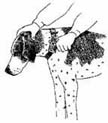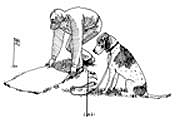Training Tips
Below are troubleshooting tips that should help you find answers to the most commonly asked questions about the outdoor dog containment system and indoor wireless fences from DogWatch. Simply click on a headline below to get the information you need.
If you don't find what you need here, we can help! Contact us.
Reinforcing The Training
 Your Dogwatch dealer will introduce you to your dog training system and provide initial training. Following this initial training by your Dogwatch dealer, you will need to reinforce what your dog already knows and here’s how. To keep your dog out of other’s yards or away from your swimming pool or patio, follow the steps outlined here. In order for your dog training system to be most effective, first place the DogWatch collar on your dog and walk the dog to all areas of your yard, near the boundary flags, several times a day for at least four to five days.
Your Dogwatch dealer will introduce you to your dog training system and provide initial training. Following this initial training by your Dogwatch dealer, you will need to reinforce what your dog already knows and here’s how. To keep your dog out of other’s yards or away from your swimming pool or patio, follow the steps outlined here. In order for your dog training system to be most effective, first place the DogWatch collar on your dog and walk the dog to all areas of your yard, near the boundary flags, several times a day for at least four to five days.
The leash is very important, because you must be able to pull the dog back to safety and praise the dog for returning to reinforce the training. For your pet training system to be successful, the keys are consistency and repetition. Praise the dog immediately upon re-entering the safe zone.
Do not allow your pet to run freely in the yard during the training period, and avoid leaving the property for walks unless you leave by car and carry the dog. This is to prevent confusing the dog about leaving the yard. After the dog has a good understanding of the audible warning, release the animal for short periods of time unattended. Observe your dog for these free times, and be prepared to reinforce the verbal "Watch Out" should the dog venture too near the boundary. Gradually increase the time your pet is allowed outdoors unattended for the first few weeks.
Collar Fit Is Critical!
 Make sure the collar of your pet training system is snug enough to keep the posts in good contact with the dog's skin. If your dog has a heavy coat, trim the fur under the receiver. Longer contact posts are available for very heavy-coated dogs.
Make sure the collar of your pet training system is snug enough to keep the posts in good contact with the dog's skin. If your dog has a heavy coat, trim the fur under the receiver. Longer contact posts are available for very heavy-coated dogs.
Remove the DogWatch collar after each training session. After the training period, the dog may wear the receiver collar during the day, but you should remove it at night and check the neck area under the collar for signs of irritation. Should the neck develop a sore, the collar is too tight. Loosen the collar to allow the area to recover and, if necessary, apply an antibiotic salve.
Taking Your Dog For A Walk
 When you take the dog off your property, remove the collar and attach the leash. Always leave the property from the same spot in the yard, such as the driveway or sidewalk. Suggest that you "go for a walk" to encourage the dog to follow you.
When you take the dog off your property, remove the collar and attach the leash. Always leave the property from the same spot in the yard, such as the driveway or sidewalk. Suggest that you "go for a walk" to encourage the dog to follow you.
The dog may hesitate the first few times you leave the yard. Another option is to set a towel or cloth down between the pet containment flags. Ask your dog to sit. Place the towel on the ground then cross through the flags with the dog on the leash. Give him a command to cross such as "good cross". Go for a walk. When you return, repeat the process and when you get to the other side of the flags, ask your dog to sit and pick up the towel. When you bring him in the house, snap the DogWatch receiver collar on your dog and bring him out to the pet containment flags to remind him of the boundary.
In addition to your local dealer, DogWatch Customer Service is always available to help you and your dog make the most of your DogWatch pet training system. Call 800-793-3436 or email us .
Training Your Dog With a Hidden Fence
Boundary Training It is necessary to teach your dog to remain within the designated boundary of your property by following a few simple guidelines and training tips. Consistency and patience is important! In about a week, your dog will know his boundaries and will be a safe and happy dog in your yard!
Your Dog’s Response To Stimulation Stimulation has been a safe and effective part of dog training systems for over twenty years. All dogs respond differently when they feel a mild stimulation. Some dogs may demonstrate little, if any, reaction, while others may yelp or jump back. Some dogs “freeze”. Do not try to comfort the dog if he receives correction from the dog training system or it will reinforce his anxiety.
Dog Personalities and Traits Keep in mind that a dog’s personality and traits differ among breeds. Dogs may not exhibit the same personalities and traits within the same breed.
Professional Boundary Training Your DogWatch dealer will ask you questions about your dog before training begins. A shy or senior dog may require longer Phase 1 sessions, while a gregarious or easily distract dog may require a short Phase 1, but longer Phase 2 or 3 sessions.
The better you know your dog, the easier the pet training system will be for both of you!
Creating The Right Environment Attitude and Consistency is Important!
1. Keep the training “light”. Use lots of praise. Keep the dog’s spirits high.
2. Use high happy tones for praise. Use low tones for negative commands.
3. Move around the boundary in the same direction.
4. Reinforce the boundary with commands. Use the commands "Watch Out!" or "Careful" as you slap or shake the flags.
5. Limit the training session to no more than 20 minutes. Keep training consistent.
6. Keep your dog on the lead in the yard for five days.
7. If you are training more than one dog, train each dog separately.
8. Use naturally occurring distractions such as a neighbor or children.
9. Contact your DogWatch Dealer if you have any questions about our pet training systems.
Remember! Proper training is essential for successful containment. If you have any questions about the dog training system phases, especially during the first few weeks, or if you have questions about your dog’s behavior during his training sessions, please contact your DogWatch dealer.
Two Zones for Training
Think of the property having two distinct zones:
- SAFETY ZONE:
This is the area where the dog is free to play.
- AVOIDANCE ZONE:
This is the signal field created by the boundary wire. When your dog crosses the signal field, the receiver collar emits an audible warning followed by a correction. When containment training is complete, your dog will remain in the Safety Zone.
Taking Your Dog Outside the Boundary
Your dealer will recommend when it is time to take your dog across the boundary for a walk. It is important to be consistent when taking your dog for a walk. Be sure to use your dog’s regular collar and leash and go to and from your walk using the same “exit” area. You can also pick up a small dog and carry him over the flagged boundary during the first weeks of implementing your dog training system.
Boundary Training Tips
1. Never call your dog to "come" or give a recall command when you are outside the flag line.
2. Never walk your dog through the flags during a training session.
3. Always reinforce the retreat concept by shaking the flags while saying "Watch out!" when your dog receives an audible warning or a correction during a training session.
4. Adjust the receiver collar, test the battery regularly, and keep the contact posts clean.
5. After the training period, your dog may wear the receiver collar during the day, but remove it at night. Check your dog's neck area and make sure thereis no irritation.
6. Keep the training consistent: 10 to 15 minutes once or twice a day.
7. NEVER throw a stick or toy in the avoidance zone.
8. ALWAYS maintain a positive attitude when training your dog.
9. Remember to praise and play in the safe zone during a traning session.
The Seven Rules
Internationally known Animal Behavior Therapist and Trainer, Raymond J. McSoley, helped DogWatch Inc. develop our dog training system and continues to be a strong DogWatch supporter. Read his testimonial on DogWatch products. In his book Dog Tales, Ray outlines seven rules for dog ownership which he conveys to every client before working with them. These rules also form the foundation for our dog training system philosophy.
Rule 1: You must be responsible for learning to communicate with your dog.
Rule 2: You must be the leader and the dog the follower - there's no room for equality in the dog's mind.
Rule 3: If you're not teaching the correct behavior, then you're teaching the wrong behavior, because you're always teaching the dog something.
Rule 4: You must be consistent in dealing with your dog.
Rule 5: Don't expect your dog to know the difference between right and wrong. He is not a little person in a fur coat.
Rule 6: You must be certain your dog understands why he is being corrected.
Rule 7: Reward your dog for the proper behavior.
©Raymond J. McSoley. All rights reserved. Published by Warner Books Inc.
